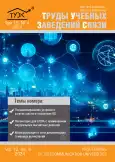Анализ методов управления дисперсией для поддержания квазисолитоного режима распространения импульсов в высокоскоростной волоконно-оптической системе связи
- Авторы: Былина М.С.1, Глаголев С.Ф.1, Доценко С.Э.2
-
Учреждения:
- Санкт-Петербургский государственный университет телекоммуникаций им. проф. М. А. Бонч-Бруевича
- ООО «Газпром трансгаз Санкт-Петербург»
- Выпуск: Том 10, № 4 (2024)
- Страницы: 16-26
- Раздел: ЭЛЕКТРОНИКА, ФОТОНИКА, ПРИБОРОСТРОЕНИЕ И СВЯЗЬ
- URL: https://journals.rcsi.science/1813-324X/article/view/263505
- EDN: https://elibrary.ru/KIGLSY
- ID: 263505
Цитировать
Полный текст
Аннотация
Об авторах
М. С. Былина
Санкт-Петербургский государственный университет телекоммуникаций им. проф. М. А. Бонч-Бруевича
Email: Bylina.Maria@sut.ru
ORCID iD: 0000-0001-9818-4060
SPIN-код: 1622-1663
С. Ф. Глаголев
Санкт-Петербургский государственный университет телекоммуникаций им. проф. М. А. Бонч-Бруевича
Email: Glagolev.Sergey@sut.ru
ORCID iD: 0000-0002-0664-9877
SPIN-код: 7148-3282
С. Э. Доценко
ООО «Газпром трансгаз Санкт-Петербург»
Email: dotsenko.sergei@ya.ru
ORCID iD: 0000-0003-0299-0469
SPIN-код: 1263-6258
Список литературы
- Андреева Е.И., Былина М.С., Глаголев С.Ф., Чаймарданов П.А. Свойства временных оптических солитонов в оптических волокнах и возможность их использования в телекоммуникациях. Часть 2 // Труды учебных заведений связи. 2018. Т. 4. № 2. С. 26–35. doi: 10.31854/1813-324x-2018-2-26-35. EDN:XRVQCL
- Андреева Е.И., Былина М.С., Глаголев С.Ф., Доценко С.Э., Чаймарданов П.А. Свойства временных оптических солитонов в оптических волокнах и возможность их использования в телекоммуникациях. Часть 3 // Труды учебных заведений связи. 2018. Т. 4. № 3. С. 5–16. doi: 10.31854/1813-324Х-2018-4-3-5-16. EDN:MAKQKL
- Глаголев С.Ф., Лыков Г.Р. Исследование возможности практической реализации многопролетной квазисолитонной ВОСС с чередованием нескольких оптических волокон // Всероссийская научно-техническая и научно-методическая конференция магистрантов и их руководителей «Подготовка профессиональных кадров в магистратуре для цифровой экономики (ПКМ-2023)» (Санкт-Петербург, Российская Федерация, 05–07 декабря 2023). Сборник лучших докладов. СПб.: СПбГУТ, 2024. С. 283–287. EDN:TZOZEG
- Агравал Г. Нелинейная волоконная оптика. М.: Мир, 1996. 323 с.
- Agrawal G.P. Fiber-Optic Communication Systems. Wiley, 2010. 626 p.
- Трещиков В.Н., Листвин В.Н. DWDM системы. М.: Техносфера, 2021. 420 с.
- Кившарь Ю.С., Агравал Г.П. Оптические солитоны. От волоконных световодов до фотонных кристаллов. М.: ФИЗМАТЛИТ, 2005. 648 с.
- Листвин А.В., Листвин В.Н., Швырков Д.В. Оптические волокна для линий связи. М.: ЛЕСАРарт, 2003. 288 с.
Дополнительные файлы






